
The Russian invasion of Ukraine and its repercussions continue to occupy front pages all around the world. The battle situation is very dynamic, but it seems that Ukraine holds ground very well and is even able to execute strong local counter-offensives against Russian forces. That’s definitely not a situation that president Putin had expected when he started his “special operation”. Internal Russian politics is unforgiving, and Putin can’t allow looking like a loser as there would be a high probability of an internal coup. So at home, in Russia, he is trying to find a way out by reframing the whole invasion as a fight for the liberation of the Donbas region. He put his fate (and probably his life) at stake on this “liberation”, but what if it goes bad for him? What if Ukraine is able to resist further, or with all of the weapons they receive, they even start to push him out? Unfortunately, there are still a few cards left up his sleeve.
One of those cards is escalation. Russian conventional armies are not as strong as everybody expected, but Russia is still a formidable nuclear super-power. While using nuclear forces in war is probably a red line for all of the mature world, there is still the possibility of using nuclear weapons for blackmailing. One possible low-probability/high-impact scenario is that Russia can suddenly detonate a nuclear warhead in the air over some uninhabited island in the polar region. Of course, the developed world will condemn this step, new sanctions will arrive, but the whole world will probably start to pay more attention.
What will be the impact of such an event on financial markets? It’s not easy to determine, but we tried to identify multiple events in the past which were also slightly unexpected and carried an indication of nuclear threat and then analyzed their impact on financial markets.
Specifically, we identified four occasions of nuclear bomb tests and one surprising rocket launch in the past and analyzed how the announcement of each test affected the Fama and French 3 Factors (Market, SMB, HML), Momentum, Short-Term Reversal Factor, Long-Term Reversal Factor, and 10 Industry Portfolios during the time of the events.
Nuclear Tests of the Past
Test 1. – Soviet atomic bomb project – RDS-1 (USSR1)
During World War II, Joseph Stalin authorized a classified research and development program to create nuclear weapons. The program was called the Soviet Atomic Bomb Project and was accelerated after the atomic bombing of Hiroshima and Nagasaki. The first Soviet atomic test, called RDS-1, was secretly conducted in August 1949. On 23rd September 1949, President Harry S. Truman informed the U.S. public about the nuclear bomb explosion. At that time, it was a stern surprise as nobody in the U.S. was expecting that Russia would have nuclear weapons so soon after the U.S.
Test 2. – “Layer Cake” Test (USSR2)
On the 20th of August 1953, the USSR press announced that the Soviets had successfully tested a hydrogen bomb. The bomb design was named “layer cake” because of its alternating layers of fusion fuel. The fusion fuel layers consisted of lithium-6 deuteride with tritium, and a fusion tamper, uranium. The explosion was about 30 times bigger than the atomic bomb dropped on Hiroshima. Additionally, its size allowed the bomb to fit on an airplane, making it a deliverable weapon. Again, not a pleasant surprise.
Test 3. – 2006 North Korean nuclear test
Six days after announcing an intention to conduct a nuclear weapons test, North Korea detonated a nuclear device in Punggye-ri Nuclear Test Site on the 9th of October 2006. The explosion of the 2006 North Korean nuclear test was estimated to have less than one kiloton of the explosive force and some radioactive output, which led the United States officials to believe that the device might have been a misfired nuclear explosive. However, according to North Korea, the test was conducted successfully, under scientific consideration, careful calculation, and secure conditions without any danger of radioactive emissions.
Test 4. – 2009 North Korean nuclear test
After Kim Jong-Il’s stroke in the summer of 2008, North Korea fell into a succession crisis. It is believed that the situation led to the country’s second nuclear weapons test. On the 25th of May 2009, the Democratic People’s Republic of Korea completed the 2009 North Korean nuclear test. The country showed that it would not give up its nuclear weapons program even in times of crisis.
Honorable Mention: Sputnik 1
The Soviet Union was the first country to launch a satellite into space successfully. Earth’s first artificial satellite Sputnik 1, was launched on the 4th of October 1957 as part of the Soviet space program. The U.S. public and government were left negatively surprised and feared they had fallen behind in the missile development. This event marks the beginning of the space race between the U.S. and the Soviets.
Nuclear Tests Events Analysis
The abovementioned events are the main subject of this article. We analyze the Fama and French 3 Factors (Mkt, SMB, HML), Momentum, Short-Term Reversal Factor, Long-Term Reversal Factor, and 10 Industry Portfolios during the time of the events.
Market During the Nuclear Tests
Firstly, we examine the market’s movement during the mentioned nuclear tests. The following figure illustrates the market’s equity curves during different periods. The black line represents the average performance during the five periods. Additionally, the zero on the x-axis signifies the day “D,” the day when each test happened. To the left from the zero are the days before the test, and to the right are the days after.
The pattern we can see in this picture often repeats with other factors. The average market reaction is not significant, but we can see that the reaction is not uniform. The North Korean tests have a negligible impact (Kim Jong-Un would surely not be pleased to see this result 🙂 ). But Sputnik 1 launch and the Russian first hydrogen bomb had a significant impact on the performance of the stocks market. What would be the impact of the intentional detonation of a nuclear warhead in the current situation? We guess it would probably be more similar to green and red lines.
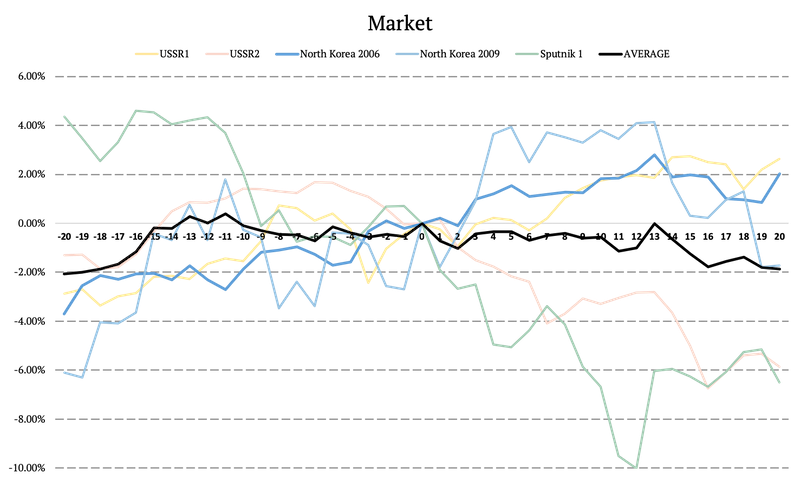
Safe-Haven Assets During the Nuclear Tests
Secondly, we look into how safe-haven assets would behave during the Atomic bomb tests. We use the 10 Industry Portfolios to create a bond-like portfolio by going long utilities and shorting the average of the nine industries ex. utilities. The long-short portfolio should have a bond-like payoff. Again, the x-axis represents the 20 days before the test, the day of the test (day zero), and 20 days after the test.
No surprise here, the price of the safe-haven-like assets goes up.
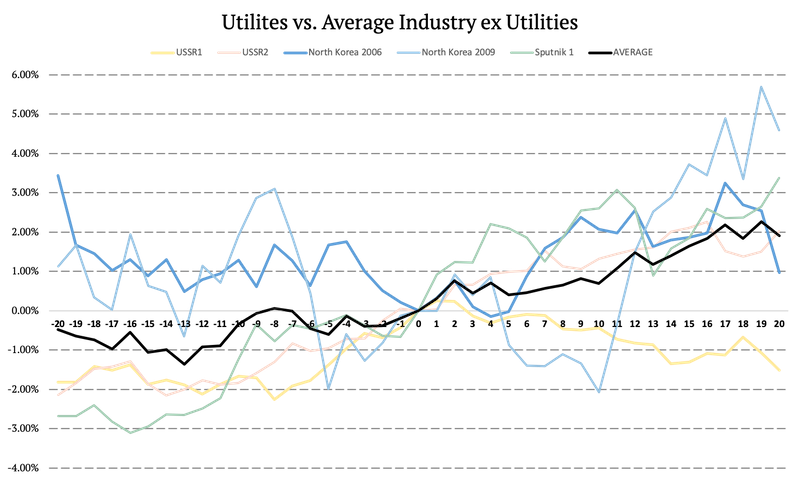
Energy Prices Proxy
Moreover, we examined the energy prices proxy/ crude oil proxy by calculating another long-short portfolio. Once again, we analyze the 10 Industry Portfolios, and we calculate portfolio that goes long energy and shorts the average of the nine industries ex. energy. Similar to the previous figures, the x-axis represents the 20 days before the test, the day of the test (day zero), and 20 days after the test.
Once again, there is a disconnect between the reaction after the North Korean tests (commodity-sensitive stocks go up) and the Russian tests and the Sputnik launch (commodity-sensitive stocks go down). Here, the reaction of markets to Russian tests is very surprising, but we would not bet on history repeating itself. At the time of the tests, the USSR (Russia) was not as significant as a commodity exporter as it is at the moment. Therefore, we would rather expect a commodity shock to the upside in the current situation.
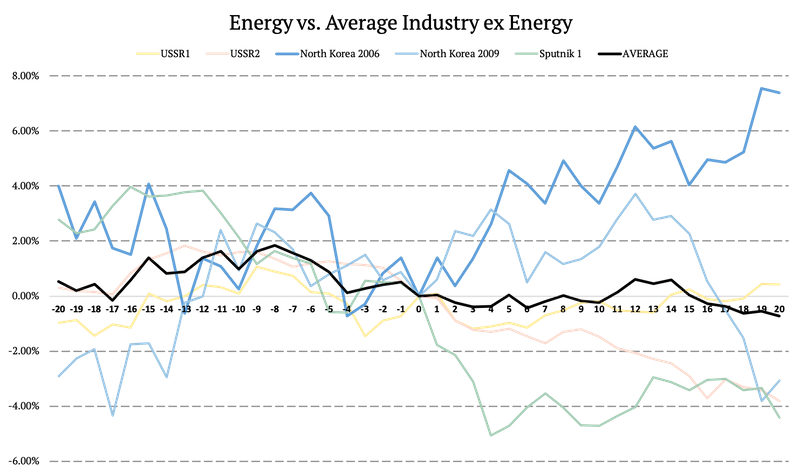
Long Term Reversal vs. Short Term Reversal
This section explores the difference between the long-term reversal factor and the short-term reversal factor during various Nuclear bomb tests. The performance of the short-term reversal factor is growing after most of the tests, on average. On the other hand, the long-term reversal factor is much more volatile after the various tests.
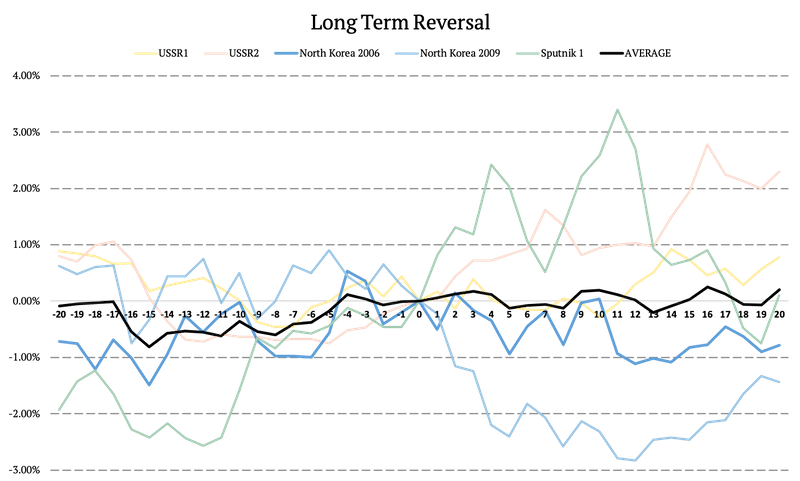
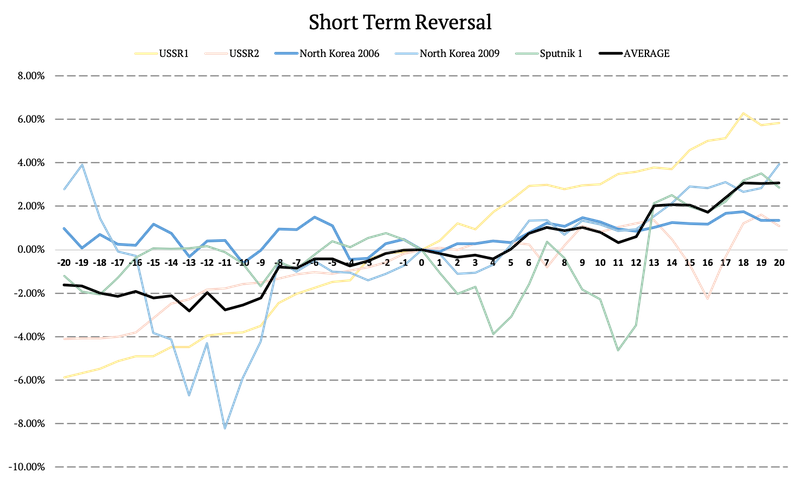
Momentum Effect During the Nuclear Tests
The figure below illustrates the performance of the momentum effect. At first glance, it seems that nuclear tests have a negligible impact on the performance of the momentum factor.
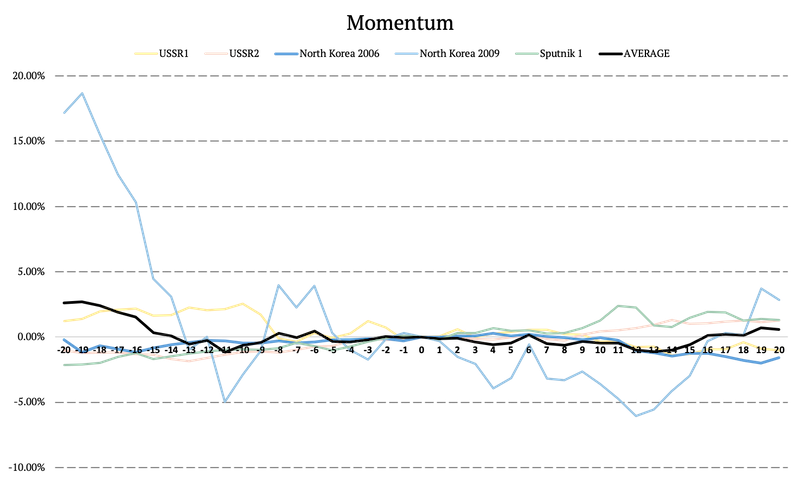
SMB and HML
Small Minus Big (SMB) and High Minus Low (HML) are two of the Fama and French 3 Factors. SMB is defined as the average return on the three small portfolios minus the average return on the three big portfolios. The performance of SMB rose significantly after the majority of the events, so small caps outperformed on average. But we again see the disconnect when small-cap stocks fell on average after the Sputnik 1 launch and after the test of the Russian hydrogen bomb. We would guess that it would probably look the same in the current situation.

Secondly, HML is defined as the average return on the two value portfolios minus the average return on the two growth portfolios. The performance started to fall after most of the tests. So value factor is probably not a hedge in the case of the nuclear threat, which is an interesting finding.
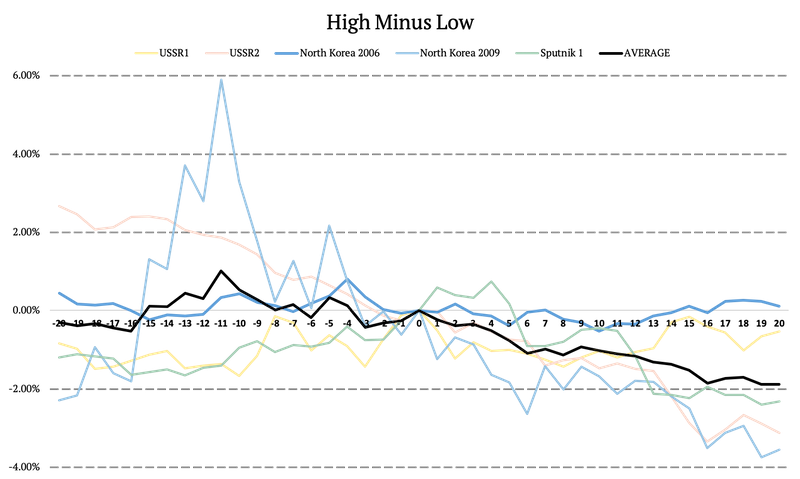
Author:
Daniela Hanicova, Quant Analyst, Quantpedia
Are you looking for more strategies to read about? Sign up for our newsletter or visit our Blog or Screener.
Do you want to learn more about Quantpedia Premium service? Check how Quantpedia works, our mission and Premium pricing offer.
Do you want to learn more about Quantpedia Pro service? Check its description, watch videos, review reporting capabilities and visit our pricing offer.
Or follow us on:
Facebook Group, Facebook Page, Twitter, Linkedin, Medium or Youtube
Share onLinkedInTwitterFacebookRefer to a friend























